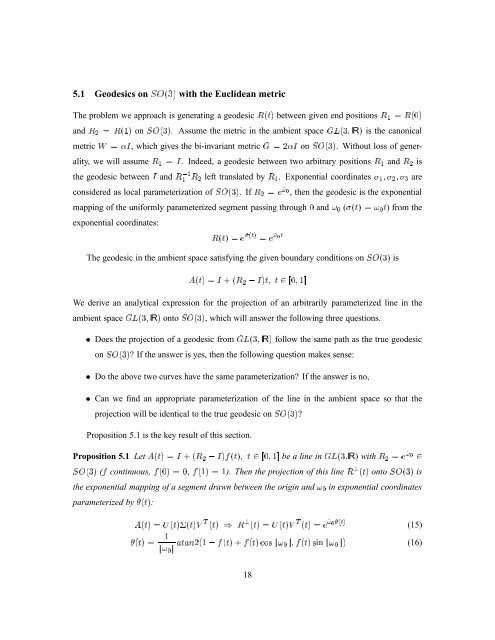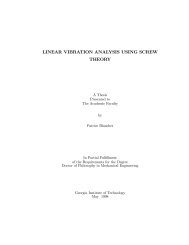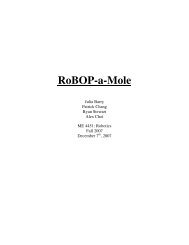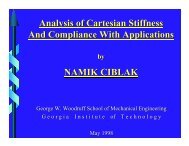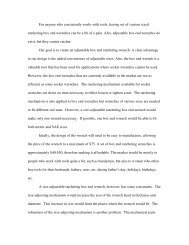New metrics for rigid body motion interpolation - helix
New metrics for rigid body motion interpolation - helix
New metrics for rigid body motion interpolation - helix
You also want an ePaper? Increase the reach of your titles
YUMPU automatically turns print PDFs into web optimized ePapers that Google loves.
5.1 Geodesics on SO(3) with the Euclidean metric<br />
The problem we approach is generating a geodesic R(t) between given end positions R 1 = R(0)<br />
and R 2 = R(1) on SO(3). Assume the metric in the ambient space GL(3; IR) is the canonical<br />
metric W = I, which gives the bi-invariant metric G = 2I on SO(3). Without loss of generality,<br />
we will assume R 1 = I. Indeed, a geodesic between two arbitrary positions R 1 and R 2 is<br />
the geodesic between I and R ,1 R 1 2 left translated by R 1 . Exponential coordinates 1 ; 2 ; 3 are<br />
considered as local parameterization of SO(3). IfR 2 = e^! 0<br />
, then the geodesic is the exponential<br />
mapping of the uni<strong>for</strong>mly parameterized segment passing through 0 and ! 0 ((t) =! 0 t) from the<br />
exponential coordinates:<br />
R(t) =e^(t) = e^! 0t<br />
The geodesic in the ambient space satisfying the given boundary conditions on SO(3) is<br />
A(t) =I +(R 2 , I)t; t 2 [0; 1]<br />
We derive an analytical expression <strong>for</strong> the projection of an arbitrarily parameterized line in the<br />
ambient space GL(3; IR) onto SO(3), which will answer the following three questions.<br />
Does the projection of a geodesic from GL(3; IR) follow the same path as the true geodesic<br />
on SO(3)? If the answer is yes, then the following question makes sense:<br />
Do the above two curves have the same parameterization? If the answer is no,<br />
Can we find an appropriate parameterization of the line in the ambient space so that the<br />
projection will be identical to the true geodesic on SO(3)?<br />
Proposition 5.1 is the key result of this section.<br />
Proposition 5.1 Let A(t) =I +(R 2 , I)f (t); t 2 [0; 1] be a line in GL(3:IR) with R 2 = e^! 0<br />
2<br />
SO(3) (f continuous, f (0) = 0; f(1) = 1). Then the projection of this line R ? (t) onto SO(3) is<br />
the exponential mapping of a segment drawn between the origin and ! 0 in exponential coordinates<br />
parameterized by (t):<br />
A(t) =U (t)(t)V T (t) ) R ? (t) =U (t)V T (t) =e^! 0(t)<br />
(t) = 1<br />
k! 0 k atan2(1 , f (t) +f (t) cos k! 0k;f(t) sin k! 0 k) (16)<br />
(15)<br />
18


